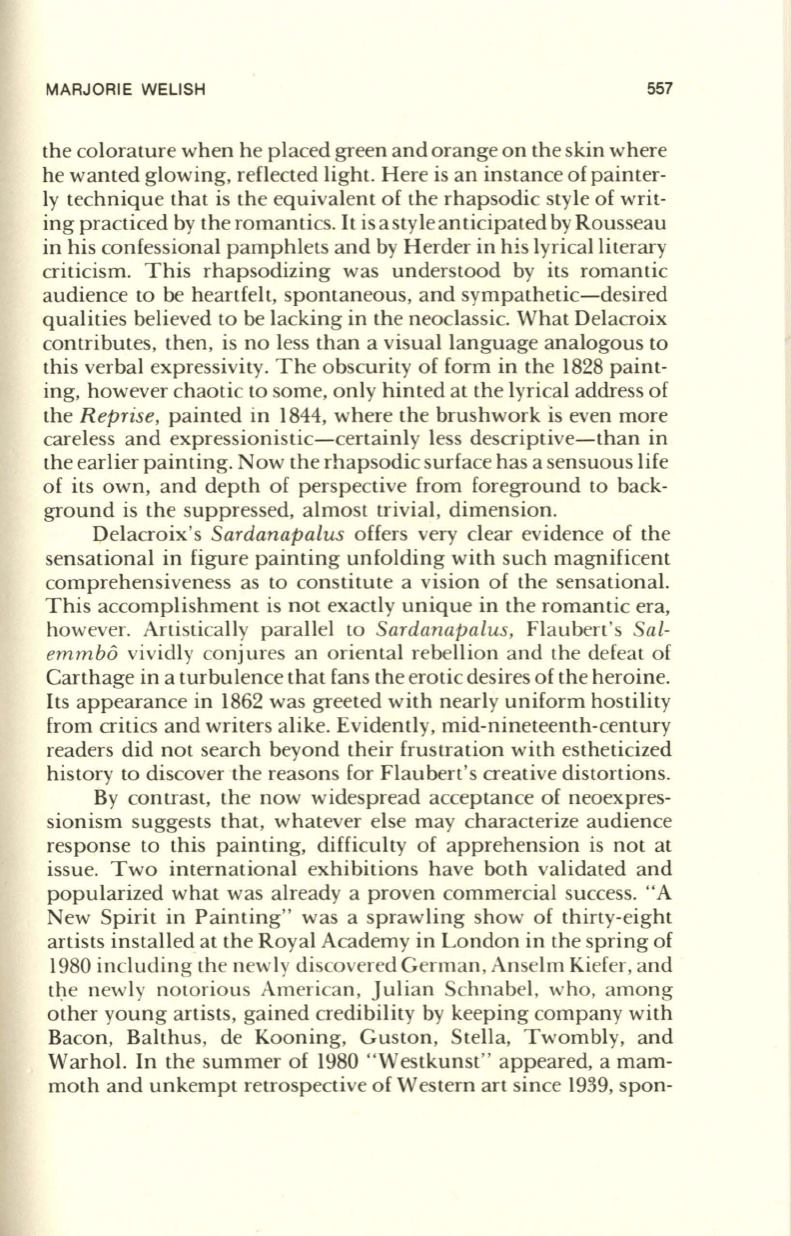
MARJORIE WELISH
557
the colorature when h e placed green and orange on the skin where
he wanted glowing, reflected light. Here is an instance of painter–
ly technique that is the equivalent of the rhapsodic style of writ–
ing practiced by the romantics. It is astyleanticipated by Rousseau
in his confessional pamphlets and by Herder in his lyrical literary
criticism. This rhapsodizing was understood by its romantic
audience to be heartfelt, spontaneous, and sympathetic-desired
qualities believed to be lacking in the neoclassic. What Delacroix
contributes, then, is no less than a visual language analogous to
this verbal expressivity. The obscurity of form in the 1828 paint–
ing, however chaotic to some, only hinted at the lyrical address of
the
Reprise,
painted in 1844, where the brushwork is even more
careless and expressionistic-certainly less descriptive-than in
the earlier painting. Now the rhapsodic surface has a sensuous life
of its own, and depth of perspective from foreground to back–
ground is the suppressed, almost trivial, dimension.
Delacroix's
Sardanapalus
offers very clear evidence of the
sensational in figure painting unfolding with such magnificent
comprehensiveness as to constitute a vision of the sensational.
This accomplishment is not exactly unique in the romantic era,
however. Artistically parallel to
Sardanapalus,
Flaubert's
Sal–
emmb8
vividly conjures an oriental rebellion and the defea t of
Carthage in a turbulence that fans the erotic desires of the heroine.
Its appearance in 1862 was greeted with nearly uniform hostility
from critics and writers alike. Evidently, mid-nineteenth-century
readers did not search beyond their frustration with estheticized
history to discover the reasons for Flaubert's creative distortions.
By contrast, the now widespread acceptance of neoexpres–
sionism suggests that, whatever else may characterize audience
response to this painting, difficulty of apprehension is not at
issue. Two international exhibitions have both validated and
popularized what was already a proven commercial success. "A
New Spirit in Painting" was a sprawling show of thirty-eight
artists installed at the Royal Academy in London in the spring of
1980 including the new ly discovered German , Anselm Kiefer, and
tJ:le newly nOLOrious American, Juli an Schnabel, who, among
other young artists, gained credibility by keeping company with
Bacon, Balthus, de Kooning, Guston, Stella, Twombly, and
Warhol. In the summer of 1980 "Westkunst" appeared, a mam–
moth and unkempt retrospective of Western art since 1939, spon-


